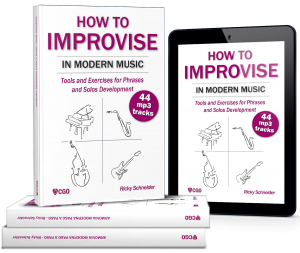Target tones or chromatic approximation
The concept of target tones or chromatic approximation notes, is based on the idea of enrichment of transit between one note to another (objective), which we shall see as main notes, interspersing secondary notes which may be diatonic or not (chromatic).
As we have seen, main notes will be those of long duration, which may fall on strong times of the bar or make a major leap to a conjoint degree. The rest will be secondary.
In this manner, and starting from a structure of reference, an arpeggio, a scale or a phrase, we shall surround the note we want to reach with notes of passage which will be below or above. This is a concept similar to a line following a bass, what is known as a walking bass.
This is to say, we shall leave from an original idea which we shall enrich with notes of passage.

With this, we shall achieve:
-Incorporating not harmonic notes (not available tensions) and/or chromatic ones within a phrase.
-Developing more extensive phrases starting from a simpler idea, especially when we are looking for a greater amount of notes and, therefore, greater speed.
When we use the idea of target tones, with long duration notes, or with a slow tempo, one will have to keep in mind that chromatic notes or not available tensions may generate very strong dissonances at some times, which will require being wary of not letting them fall on strong times, as in the previous example.
On the contrary, in quick phrases of short duration, we will be able to move with greater freedom, as long as the objective note is a harmonic note (arpeggio note or available tension).
We shall apply the use of target tones to simple melodies, scales and arpeggios, and plan a series of exercises with the end of making their use mechanical until it may be incorporated as another manner of playing arpeggios or scales.
In order to become familiar with the use of this resource, it will prove useful to take our time at different combinations for reaching from one note to another depending on the distance separating them.
Exercise TT Intervals
– Look for different interval leaps that may appear in a scale or an arpeggio (b2, 2, b3 and 3) and find different paths to reach from one note to another (diatonic or non-diatonic), practicing each one of them individually.
Depending on the scale being used, watch where not available tensions or chromaticisms (strong or weak times) fall for phrases with long-duration notes.
Exercise Target tones in Melodies
-Look for a phrase or a melody which you have listened to often and including notes of long duration.
-Intersperse ascending and/or descending notes of passage, to reach from one main note to another.
-Depending on the degree of dissonance you may be looking for, use diatonic (harmonic or not harmonic) or non-diatonic notes.
-To maintain the “main” sonority of those notes, exaggerate their stress.
Scales
We may see a scale as an arpeggio (target tones) where we intersperse the tensions (notes of passage) since, as in an arpeggio notes go by threesomes, tensions will remain interspersed among them.
In this case, all notes will be diatonic to that scale.

Within the same scale, we may combine diatonic and non-diatonic, ascending or descending notes, and different rhythmic patterns to break the linear sonority.

Exercise Target tones in Scales

-We shall look for a scale whose fingering we know very well, and play the quarter notes.
-We will incorporate ascending or descending notes of passage between each degree of the same figures.
-First, 1 note (quavers).
-Then, 2 notes (triplets).
-And last, 3 notes (semiquavers).
-Repeat this with different fingerings of the same scale.
-Combine different rhythmic patterns so that phrases do not sound as exercises.
-Repeat this with other scales.
Ejercicio Target tones in Arpegios
Using the same approach, we shall take objective notes to be arpeggio notes and connect them with notes of passage.
– We will look for an arpeggio and play the quarter notes.
-We will incorporate ascending and/or descending notes of passage between each degree with the same figures.
-First, 1 note (quavers).
-Next, 2 notes (triplets).
-Lastly, 3 notes (semiquavers).
-Repeat this beginning on different notes of the arpeggio.
-Look for combining different rhythmic patterns so that phrases do not sound as an exercise.
-Apply this on different forms we have seen of playing arpeggios: extensions by thirds, substitutes, etc.
-Repeat this with other arpeggios.
Often, the use of an arpeggio turns out to be limited to the time for developing a phrase at a great speed, since we will need a great amount of notes. With this resource, we may extend the 4 notes of an arpeggio to 16, which will multiply even further if we add other resources we have seen when using and combining arpeggios.
Practice this periodically on arpeggios and scales you know until the use of this resource becomes familiar.
The next step will be to look for their musicality developing a more creative use of the concept by combining different forms of applying it to the same phrase, especially if we want to increase the tension: diatonic and non-diatonic notes (ascending and/or descending) figures of different duration and their combinations, note leaps, etc.
 This post is part of my book
This post is part of my book
How to Improvise im Modern Music
available in






Leave a Reply
Want to join the discussion?Feel free to contribute!